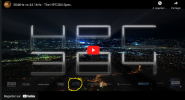hi
I do not pretend to revolution this thoerem.
I just hear a difference between 44.1 khz and 96 khz when I mix.
especially the treble which becomes less aggressive at 96 khz than 44.1 khz .
and yes i have data telling that this theory is impossible to apply perfectly here :
I am interested in building a synthesizer but I am confused about the Nyquist-Shannon Theorem and sampling rates. If I sample a 20 kHz sine wave at 200 kHz and plot the data points, the plot looks

dsp.stackexchange.com
here they say that : "you need an ideal brick-wall filter (infinitely sharp transition band) called a
reconstruction filter. Unfortunately, such a
perfect filter is impossible to obtain"
and they say also this : sampling you signal at a higher frequency will result in a periodisation of the signal at a longer period, which basically gives more space for your filter's transition band .
so maybe use higher frequency give a better
reconstruction filter .
so a the end a better sound....
Yes, there needs to be a reconstruction filter, and because of how they work and the practicalities of electronics, you cannot actually reconstruct a frequency at the exact Nyquist limit of your sample rate. With this in mind, it is important to note that if you are hearing differences, and if those differences could be consistently heard in a proper blind test, what you're hearing is not the differences in the sample rate per se. What you would be hearing would be differences in the sample rates as reconstructed by and played back through the particular DAC you are using. This is an important distinction because we cannot assume that every DAC will reconstruct different sample rate signals in precisely the same manner.
The fact that frequencies at or extremely close to the Nyquist limit cannot be perfectly played back is the main reason why the CD standard does not sample at exactly 40kHz in order to be able to reproduce sounds at 20kHz - you need some buffer or "wiggle room" above that for the reconstruction filter, because the filter cannot immediately "slam on the brakes" by letting frequencies up to 20kHz through and then attenuating frequencies starting at 20.0000000001kHz by the necessary 70 or more dB to prevent them from audibly aliasing into the audible band.
A sample rate of 44.1kz enables the recording of frequencies up to 22.05kHz, thereby providing 2.05kHz of room above 20kHz for the reconstruction filter to start attenuating out-of-band signals.
Modern reconstruction filters are perfectly capable of doing this with no audible distortion or other ill effects - BUT, for a number of reasons many DACs use "slower" filters that do not attenuate signals above 20kHz very quickly and in some cases do not attenuate them very much (perhaps 40-60dB).
Since aliased frequencies "mirror" into the audible range, higher sample rates can potentially make it less critical to use sharp, fast filters. For example, if you have a sound at, say, 25kHz and you are using a 44.1kHz sample rate, and your DAC's reconstruction filter does not attenuate out-of-band signals enough, then a low-volume version of that 25kHz frequency is going to be played back through your DAC and into your amp and speakers - but it won't be played back at 25kHz. It will alias at a frequency of about 19kHz. The reason is that 25kHz is just about 3kHz above the 22.05kHz Nyquist limit of a 44.1kHz sample rate. And 19kHz is just about 3kHz BELOW that same Nyquist limit. That's what aliasing is: frequencies above the Nyquist limit that improperly make it though the reconstruction filter will be output in the analogue section of the DAC as frequencies below the Nyquist limit, since those are the only valid frequencies for that sample rate - and the incorrect frequency will be set as a "mirror" of the original one, with center point of the "mirror" being the Nyquist frequency.
So... if you have, say, a 96kHz sample rate, then you can sample all the way up to 48kHz. That 25kHz sound in the recording will get passed through the DAC as 25kHz - so it will be accurate to the original recording, and most importantly it will be above the audible range of human hearing so it will have zero impact on the audible sound. And if there is, say, a 51kHz sound on the recording somehow, and the reconstruction filter improperly lets it through, it will alias into the DAC's output at 45kHz (because both 51kHz and 45kHz are 3kHz away from the Nyquist limit of 48kHz). But it won't matter because 45kHz is still way outside the audible range.
With all that said, however, it is extremely unlikely that anyone - especially any adult over the age of about 20 - is going to hear a 19kHz alias of a 25kHz signal fed through a DAC decoding a 44.1kHz sample-rate signal. We just don't hear up to 19kHz in most cases, and even those of us who do hear that high are not in most cases going to be able to detect an aliased 19kHz signal if it's attenuated by even 40dB, let alone 60 or 70dB or whatever, since all human hearing, even among people who can hear to 20kHz, gets a good deal less sensitive at frequencies that high.
One other factor is that ANY frequency in ANY sample rate recording can potentially created intermodulation distortion (IMD) when it mixes with other frequencies. This can be really unpredictable - for example a 49kHz signal mixed with a 52kHz signal will produce intermodulation at 52 minus 49 = 3kHz, which is smack in the middle of our most sensitive hearing range. In that sense a higher sample rate can let more frequencies through, which by themselves are useless to us since they are above the audible range, but can potentially create more IMD simply because it has all those extra frequencies in the signal.
So reconstruction filters can potentially have some impact on the sound, and that impact might be more or less audible depending on the sample rate used, because of where he aliased frequencies are in the spectrum, and also because of how much intermodulation distortion might end up in the playback.





